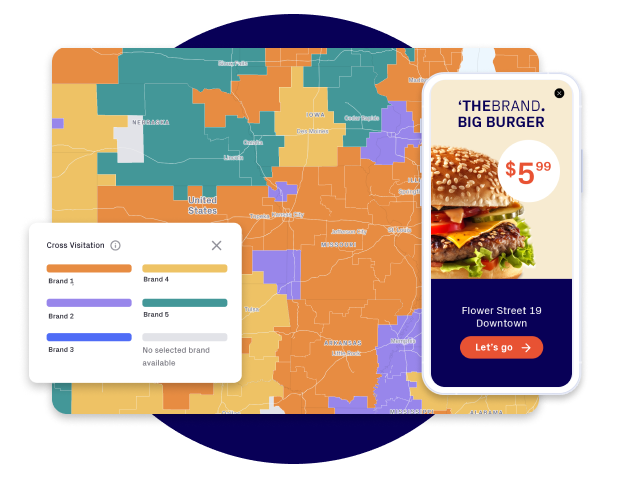Adapting Targeting Strategies to Local Behaviors
For QSR marketers, traditional targeting methods are insufficient at the local level, where consumer preferences and competitive dynamics vary. Locala’s pivotal expertise in cross-visitation insights is a cornerstone of our Retail Analytics suite and holds significant importance in this context
By analyzing where your customers dine beyond your brand’s locations, Locala can provide a unique view of your competitive landscape. Successful QSR campaigns require adapting to local market behaviors, each with distinct challenges and opportunities. This precision in activation, tailored to local preferences and cultural nuances, is crucial in today’s market where generic strategies fall short.
This article explores how fast food brands can leverage cross-visitation insights to refine their marketing strategies, staying relevant and competitive in varied local markets.
Deep Dive into Cross-Visitation Insights
Cross-visitation insights refer to the analysis of visitation overlap across brands, calculated on a local basis and monitored over time. This involves understanding how many customers of one QSR brand visit other brands, providing a clear picture of the competitive landscape.

The methodology behind tracking and analyzing this data involves leveraging mobility (mobile location data) and places data (such as restaurant locations and other metadata), allowing brands to track foodies’ visits among local competitors effectively. This methodology complies with privacy standards, as Locala ensures that all data collection and analysis adhere to stringent privacy regulations such as GDPR and CCPA, assuring both brands and their customers of ethical data usage.
Unpacking the Strategic Value for Fast Food Brands
The true value of cross-visitation insights lies in their application at the local level. These insights allow fast-food brands to adapt their targeting strategies to local shopping trends and competitive environments. For instance, if Burger King finds that 40% of its visitors also frequent McDonald’s and that 25% of them also eat out at the nearby salad bar in one area, they should include visitors from both locations in their local targeting strategy. This approach enables brands to maintain a presence among the most relevant consumer segments and attract potential customers with similar purchase intentions.
Diving at the local level means that a brand can not only see the general trends of customer behavior but also understand these patterns in specific areas. For instance, the cross-visitation trends in a bustling city center might differ vastly from those in a suburban area, even within the same city. By harnessing these insights, brands can tailor and activate their strategies to each unique area.
To help brands get started, we’ve compiled a few best practices for local market adaptation:
- Retargeting Based on Visits to Local Main Competitors
- Geo-Fencing Local Main Competitor Locations
- Loyalty Incentive Campaigns Targeting the Least Loyal Customers
- Dynamic Ad Content Based on Time of Day and Distance to Locations
- Local Customers Lookalike with Other Cross-Visited Brands
Seamless Integration with Omnichannel DSP
The integration of cross-visitation insights with our omnichannel DSP simplifies the process of executing targeted marketing strategies across various channels. Whether it’s desktop, mobile, audio, DOOH, or CTV, this seamless integration ensures that QSR brands can engage with their customers wherever they are, with messaging that’s relevant to their local experiences and preferences.
Case Study: Miller’s Ale House
A prime example of these strategies in action is the campaign Locala recently implemented for Miller’s Ale House. By leveraging dynamic commerce areas and cross-visitation insights, Locala was able to reach current, lapsed, and new consumers of Miller’s Ale House, driving a significant increase in foot traffic and return on ad spend. The campaign involved a mix of desktop and mobile display ads, specifically tailored to drive restaurant visits. The step-by-step strategy included identifying target areas, segmenting the audience based on visitation patterns, and then deploying localized ads that resonated with these specific customer groups. The results? A 9.67% footfall uplift, 13k+ in incremental visits and an overall 9x ROAS for Miller’s Ale House.
The Power of Hyperlocal
The future of marketing in the QSR industry is hyperlocal, data-driven, and customer-centric. By harnessing the power of cross-visitation insights, QSR brands can stay ahead of the curve, adapting swiftly to local market changes and consumer behaviors. Locala’s advanced analytics and technology are not just tools; they are essential partners in this journey, helping brands navigate the complex landscape of local markets with agility and precision. As we move forward, the brands that succeed will be those that not only gather these insights but also act on them with precision and creativity.
Engage with us on LinkedIn | Learn more about Locala’s solutions